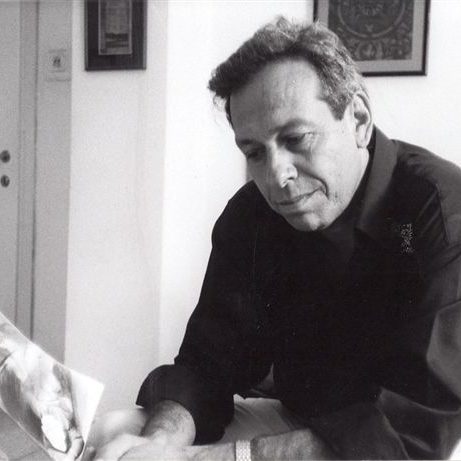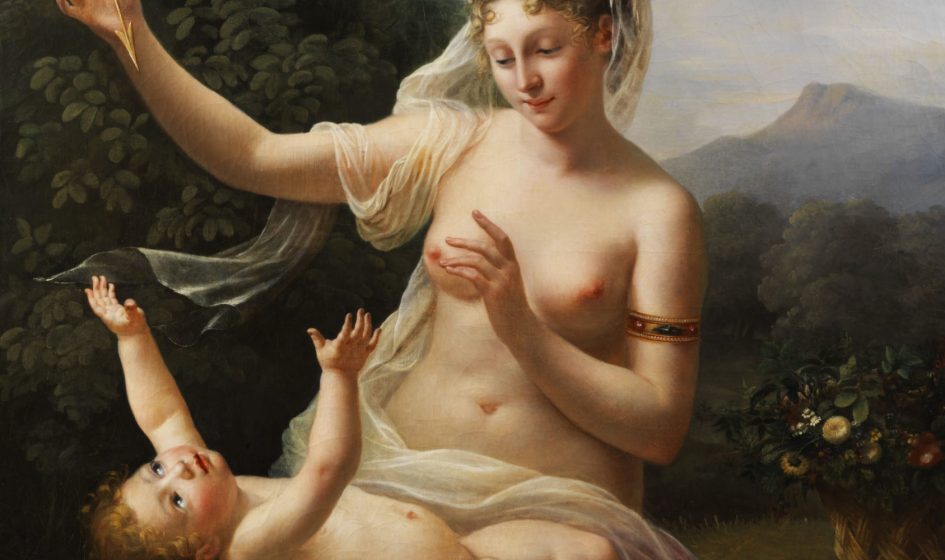The first aim of this article is to reveal and present the dark, hidden motivations and needs of the archaic mother figure, which permeate the maternal relationship and maternal love in general. The second is to discuss the possibilities, and prototypical situations of the mother-child relationship, and the obscure motivations and needs they evoke. The third is to shed light on the personal corridor through which one may reach this hidden side of motherhood. It will reveal, recognize and identify those motives and situations through mythological stories of mother-child relationships, which emphasize the tragic story of the mother.
These stories about mothers mark universal human maternal motivations and needs. Jung's archetypal approach chooses to relate the complexity of maternity through myth, as myth testifies to the primordial aspect of the dark dimension of motherhood.
Background
The various psychoanalytic theories regarding the figure of the mother leave a large lacuna. Although most theories assign the greatest importance in the child's development and the formation of its character to the figure of the mother, there is hardly any reference to the mother herself, and to the dynamic of her many forces.
Psychological and psychoanalytic literature seldom deals directly or theoretically with the dark side of motherhood: with the ugly, anti-maternal secret face penetrating the mother-child relationship.
That is to say, in both therapy and in analysis, we do encourage the patient to blame the mother; usually she is accused of being the cause of his or her mental illness. In the various psychoanalytic theories explaining the formation of psychological problems, we find no reference to the mother's hidden motivations.
The wake of the birth and appearance of the new child is also characterized by primacy, power, and hope for the mother, but there is not sufficient clear reference to the drives, the needs, and the negative aspects arising within the mother. Similarly, there is insufficient reference to the immanent variables in mother-child relations, which can arouse the mother's hidden faces.
For example, the infinite and absolute dependence of the child on its mother can awaken the mother’s unconscious resentment, posing a threat to her freedom, at the same time as it instills a sense of power and control such as she has never previously experienced. Another variable is the infant's powerful life-force, the enormous vitality it contains within itself, and with which it imbues its surroundings.
This factor can awaken new feelings in the mother, as well as a deep need to live through someone else. This strong erotic reaction, contained within the intimate mother-child relationship, can arouse incestuous desires in the mother or awaken unfulfilled needs for love and warmth. The connection with the darling, charming infant may bring its mother possible narcissistic satisfactions. Those satisfactions, which it is meant to give her, may bring to life repressed desires for splendor, self-importance, and prominence within her; alternatively, they may call forth latent shame or repressed inferiority.
Most theories see the child as small and developing, and the mother as adult and formed, so that the factors inherent in the special mother-child situation, especially its “dark” motivations and behavior, are attributed to the child. Only in exceptional instances, when she is problematic or pathological, will the mother's motivations or needs be seen as pernicious. Usually it is the child who is described as having incestuous or Oedipal desires, possessing narcissistic needs or envy; the mother's motivations are mentioned neither on the theoretical level nor in clinical descriptions.
Sigmund Freud related to the child's incestuous desires toward its mother, but he did not relate to the mother's parallel needs toward the child. Similarly, in Freud's account of the oedipal triangle, he described the child's aggressive urges against the father, but not those of the father toward him. Freud did not relate to the new drives and motivations of the parents produced by the child's arrival in the world, not even those appearing in the myth of Oedipus, upon which his theory is based (5).
For example, he did not attribute importance to the fact that Jocasta, Oedipus' mother, was the one who desired a baby so intensely she brought it into the world deceitfully, by making the father drunk with wine. Nor did he relate to the fact that the fears of the father, Laius, and his rejection of the infant, preceded the child's urges and desires.
Melanie Klein also mainly related to the development of the infant and not its mother: according to her theory, the child is born with envy, anger, and destructiveness, transferring them to the primal connection with the mother through a mechanism of projective identification.(6) Klein did not deal with what develops within the mother in this specific situation: what she brings and transfers to the child, perhaps through the very same mechanism. Heinz Kohut did not relate to the figure of the mother, but to the needs of reflection and mirroring from her. (7 )There is no room for the question of why the child’s needs were not satisfied, much less what the mother's needs were in that very situation.
Only Donald Winnicott related to the special psychological condition of every mother after the birth of a baby. He claimed that not enough attention had been paid to what he called the “Primary Maternal Preoccupation,”(8) a particular psychiatric situation that develops in the mother before and immediately after the birth. He described this as a syndrome of withdrawal, dissociation, or even temporary psychotic disturbance.
According to Winnicott, this is a kind of “illness,” which is somewhat vital to maternal devotion. The maternal regression can hint at a fissure, through which a dark and unconscious part of motherhood is liable to penetrate the exclusive, shared circle between her and her child.
According to Jung, the mother's special situation intensifies and activates archaic maternal images and experiences in her psyche; along with her own personal experiences with her surroundings– especially with her mother and father– these will determine and influence her actual mothering. Unresolved complexes penetrate into the mother's psyche, and perhaps into even deeper shadows, which have never risen to the surface; this may be attributed to the regression to which the mother is subject, and to the influence of her past experience.
It is important to emphasize that the degree of influence of these complexes; how far they penetrate, and how much they allow the archaic material to express itself in life, also depends on the nature of her spouse– the husband, and the father of the child.
Motherhood According to Jung
- G. Jung saw the figure of the mother, with all its contradictions, as the source: the key to the door of the unconscious, to understanding and self-acceptance, to development, and to possibilities of renewal. The figure of the mother is not identical to the unconscious, but if we listen to its voice within us, and allow the descent into the inner emotional tangle she causes– for better and for worse–we will rediscover the entrance to the unconscious. (1) Jung claimed that if we ignore or refrain from an awareness of the image and identity of the mother, we will not solve the personal mystery of the mother with whom we grew up. Because our impression is only partially conscious, we must learn to recognize the hidden negative of her image. At the same time, we will not reach a deeper understanding until we realize that–for better or for worse– as important as she is in our lives, our mother bears for us the image of the Great Mother. According to Jung's theory, it is important that through one’s inner self-experience of maternity, the personal mother is brought down to the human level. A large burden is always placed on the mother, comprised of our expectations of her: her unfinished responsibility for our fate: the enormous debt that she owes us: the earth, heaven, and hell that she was for us. All of these are placed upon the shoulders of a single, fragile, erring woman, while in fact most of them appertain, instead, to the Great Mother.(2)
In order to understand the inner experience of maternity, one must recognize two important components of the truth. First, there is the massive, unconscious projection of archaic images of the mother– both positive and negative– and second, the recognition of the various faces of the personal mother, the woman who raised one, whose faces partially activated the projection. For example, a negative or harmful experience of the personal mother can create a kind of dark corridor through which negative archaic images of the mother encroach, at different periods of life. The tendency toward idealization of the mother is one of the obstacles preventing a comprehensive view of that figure, although most psychological theories claim that this mutual idealization of the mother on the part of the child, and of the child on the part of its mother, is necessary and required for the proper development of the self.(3)
The child's picture of the world can be deeply influenced either by the extreme idealization of the mother, or by premature disappointment.(4) The strong need to imagine a lost paradise blurs the picture of the mother–which, even in the form of the Great Mother, has presented eternally with two faces. In mythological sources and in fairy tales, the bad mother, as splendid as she may be, always actively served her own dark and hidden purposes. If the Mother was great, a goddess, she was also bipolar; thus it is no wonder that when a flesh and blood mother raised a child, strange and disparate and motivations should enter the maternal connection, beyond her intention to raise the child as a natural extension of herself. From time immemorial, the disguised personal needs of the mother invaded this connection; the raising of every child involved service not only to itself, but to its surroundings.
The Use of Myths for Understanding Motherhood
The Jungian approach claims that a profound understanding of the psyche is not acquired through exact scientific research, nor from experiencing the personal world, but through connecting to the ancient cultural world residing within our souls.
"Man brings with him systems that are organized and ready to function in a specifically human way and this owes to a millions of years of human development…..man brings with him at birth the ground plan of his nature and not only his individual nature but of his collective nature.. only the individual consciousness experiences this things for the first time" (cw: vol 4 part 728).(9)
From this point of departure, the investigation of the negative,
Dark faces of the mother figure and of mother-child relations can be reinforced by ancient stories. In many tales the figure of the mother is split between the Good Mother and the Bad Mother; usually the good mother dies, and the bad one–or stepmother– introduces evil, presenting the selfish, harsh, and ugly face. The stepmother seduces the child, using it for her purposes; she abandons it, or wants to devour it, or puts a spell on it, thus preventing its development for her own needs. The powers of the bad mother over the little child are intensified mainly when the father is not present, when he is weak, when his image is feeble, or when he is under her dominion.
In Greek mythology, which is more ancient than fairy tales, at first the figure of the mother is large… She appears as a powerful goddess who undergoes many transformations. She is the earth itself, from which everything grows, she is nature itself, the defense against dangers; but she may be transformed into a possessive mother, seizing the child as her own property. An example of this is the Greek myth of Kore, the daughter of Demeter (the Great Mother), who cannot free herself from the bonds of her mother without a secret kidnapping, occurring behind her mother's back. This myth deals with the separation of mother and daughter.
First the Great Mother guards her daughter intensely, wanting her only for herself; but the daughter's needs for autonomy, her curiosity, her desire to develop and learn about life by means of the patriarchal powers of the gods, bring about a separation from the mother and produce a new situation. The myth of the Great Mother ends with the mother's acceptance of the change, and her conceding the symbiotic relations with her daughter. After her loss, despite anger and depression, the mother accepts the daughter's vital need for separation to make her new life possible.
This is a vital psychic stage for all of us, and therefore every mother must allow its formation. Only development which separates us from the omnipotent mother creates full psychic life on both sides. The mother who is sufficiently well-developed takes upon herself the inevitable separation from her children, and understands its importance to the dynamic cycles of life.
One of the most difficult aspects of the Great Mother is her own strong dependence on her children to actualize her power and vitality. Erich Neumann emphasizes the dependence of the mother on her infant and calls this situation of mutual dependence “Reciprocal Bliss.”(10 )According to Neumann, at this stage symbiosis, which characterizes the first months of the infant's life, is necessary, giving the mother huge power over her child.
"Woman exists from the everlasting self-subsistent, immutable; man, evolving, is subject to continual decay…..The first earthy manifestation of masculine power takes the form of the son. From the son, we infer the father, the existence and nature of masculine power are evidence only by the son" (Bachoffen in Neumann, p. 47). (11).
When the mother gives birth, she is under a great enchantment, “When a man is born from a woman's womb, the mother herself marvels at the new apparition. For she recognizes in the form of her son the very image of that fecundating power to which she owes her motherhood. Her eyes linger with delight upon his limbs "(Bachoffen in Neumann, p. 48).12
In many ancient myths, a prominent theme is the mother's harsh and cruel resistance to surrendering her children, who supply her needs. As portrayed in myth, in relations of this nature, there is no possibility for separate growth, no room for anyone else besides the mother, no liberation from her figure; frequently these mothers make their male children into a kind of “lover-son.” Such tragic cases can be seen as a display of the dark even dangerous face of motherhood.
These mythological stories of the failure of good motherhood and the victory of the dark face, end in the death of the children, and their being turned into lovely flowers like violets, poppies, and narcissus. Unlike the mythological hero, who succeeds in extricating himself from and overcoming the maternal bond by leaving the mother and setting out on the voyage of life, these lover-sons fail in their tasks. They remain immobilized, under the mother's hegemony, unable to live their own lives.
Although the myths that I present below speak of mothers and sons, in my view they relate to the “young self” of both sons and daughters, which needs separation and independence.
Through these myths emphasizing the personal story of the mother-figure, we may learn a great deal about the mother who fetters her children with impossible bonds. Furthermore, these stories can help us understand and reveal the negative, sinister part of every relationship to which the maternal relation is central, including the relationship between therapist and client, or between counselor and the counseled.
The characteristic shared by the three mothers in the myths I present is their overwhelming, desperate need for a child. These are women for whom “the kingdom of the mother,” as Neumann calls it, (10) is not self-evident in their lives, but depends intensely on the son to be born, who in some way grants her the very right to exist.
For every woman the birth of a child is an exceptional event, evoking and bringing into existence her Holy of Holies; at the same time it awakens all her own primordial problems and complexes. Motherhood can arouse great expectations in women seeking compensation or reparation for painful experiences in their personal past, damaging to their womanhood.
The full story of the mother will provide a possible explanation for the creation of this shadowy side of her soul, and ease from the children’s shoulders the full weight of failure inherent in the process of separation and individuation. Neumann said of the son- lovers that they are beautiful and make the mother happy, like spring fertility celebrations. (13) But, as in the drama of the “gifted child,” about which Alice Miller writes,(14) they are not meant to live their mothers' lives.
Cybele (the Axe-Goddess), the Mother of Attis(15)
The Mother who Restores her Power and Control by Giving Birth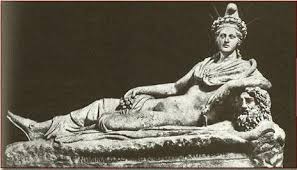
This myth is an ancient Phrygian story about Cybele (who is also called Agdistis) and her son-lover, Attis. Here is the myth:
Once, when the god Zeus was tired, he found a resting place in one of the mountains, which was shaped like a huge and mighty woman. While in a deep sleep, he ejaculated semen, which was absorbed by the earth, and a large, powerful being was created, which developed as both male and female. This strange creature, which was named Agdistis, wandered about in the world, happy and good hearted, but its perfection frightened the gods very much, and they decided that they had to determine its gender. In the discussion among the gods, it was decided that the male organ would be removed from its body, and it would continue to live in the world as a female.
The gods' plot was quite cruel. Dionysus, the god of instincts and wine, volunteered to create a temptation in the form of a small spring of wine, which would flow next to the place where the creature was resting. The bi-sexual Agdistis discovered the wine, drank it, and fell into a long slumber. While it was asleep, the gods cruelly tied its impressive male organ to a nearby bush, and when it rose from its sleep, its member was painfully torn off. The suffering creature gave a huge shout. Wounded, it left the place and became a woman, whose name was changed to Cybele (the axe-goddess). As a woman Cybele retained power from the sparks of the god Zeus, and these sparks made her into a kind of witch-goddess, with special powers. The myth also tells us that in the place where her male organ fell, a huge and mighty tree grew, which produced special almonds, and that in time it became one of the trees in the orchard of King Sangarius.
The king's daughter, Nana, used to sit at the foot of the tree and play. It is told that once, while Nana was playing with one of the almonds, the marvelous fruit moved between her legs and fertilized her. From this game she became pregnant, and, to her father's dismay, she gave birth to a darling, lovely baby. But the king, Nana's father, decided to imprison his daughter, to starve her to death, and to remove the infant from his palace. It is told that the beautiful baby, Attis, was abandoned, but he was raised by a He-goat, which had a special ability to give the baby milk. The child wandered about as an orphan and met Cybele, who fell deeply in love with him and adopted him as her son. Cybele continued to raise and nourish her son lover, Attis, who became her consort.
When the boy reached sufficient maturity a princess, the daughter of King Midas, saw him and wanted him as a groom. King Midas wanted Attis as a groom for his daughter and Cybele was filled with pride because of this request and agreed to hold the wedding. However, on the wedding night, Cybele suffered greatly, and her heart would not allow her to part with Attis, her lover-son. She was dreadfully jealous, and in her anger she employed her occult witchcraft. She struck both Attis and King Midas with madness. In his madness, Attis castrated himself and shouted out loud, “Cybele, Cybele, I return to you.” He fell at her feet, wounded, and died, and violets grew and bloomed from the beautiful Attis' blood. Cybele begged for her son's life, and Zeus answered her prayer in part, agreeing that Attis' body would not decay, his hair would grow despite his death, and only his little finger would continue to move.(16)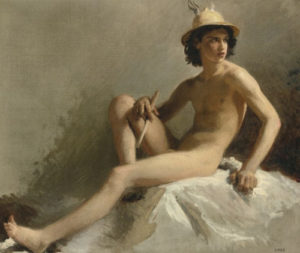
The transformations of the beautiful child Attis, bespeak birth and development in the shadow of tragedy, the tragedy of a powerful mother emasculated: a mother whose phallic powers and instincts have been taken from her.
Through giving birth to a boy, and raising him as a mate, or consort, she sees the possibility of recovering those powers. The story presents a bi-sexual mother, born in nature, by chance, without parents, yet strong– even omnipotent. Themes of emasculation, loss of power, transformation into a woman, and regaining power through the son, are central to this narrative.
In the myth of Attis, Agdistis, Cybele, and Nana, as well as the androgynous He Goat, symbolize parts of the mother. Stories of this kind have been told, and are still told, in every age; the castration, of the woman, the removal of her power and instinct, are present and possible in every culture. This myth may be applied to personal stories as well, in which parents deprive the daughter of her power. The power is not eliminated, but instead descends underground, through the fertile almond tree; characterized by injury, it seeks an outlet through the continuation of life. Becoming a mother opens the possibility of reconnecting with this component of the woman's psyche, through her children. While it might appear that compensation would be greater with the birth of sons, due to the concept of castration, it can pertain to any birth.
The act of giving birth and becoming a mother creates a new hegemony, involving total control of the child, and raising once again the subject of the young mother's power.
This story sheds light on the central, yet hidden, ominous side of maternal power– the ascendancy that a woman gains through the new dominance of motherhood. The power and control which emerge when the woman becomes a mother, reinstate her maternal supremacy in relations with both her children and her husband; they extend to the outer world as well, since the mother who gives birth to beautiful progeny has always enjoyed a special status.
In the myth of the Hebrew matriarchs, Sarah, after the birth of Isaac, displays her power and status by driving out Hagar. Rebecca deceives Isaac by way of Jacob, and though Rachel is loved, Leah draws authority from her fertility. The child who grows up in a maternal environment characterized by his mother’s need for supremacy, is liable to conceal, or even deny, his own power and independence, out of fear of losing his mother's love. “Cybele, I am coming back to you,” Attis cries out and castrates himself, renouncing his potency for the sake of a relationship with his mother. He will never be the tall boy, proud of his strength, taking his proper place.
Giving up his strength for the sake of his mother’s love is a result of the same lack of effective motherhood: a motherhood which involves loving and accepting the child, enabling him to express his will, realize his strength, and take his proper place.
The second myth shows another latent aspect of maternal love: it is Eros and love that give life.
Myrrha (the Weeping Beauty) and Adonis (16)
The Mother who Draws the Power of Life and Love from her Children
A Greek Myth, with Syrian Influences: the Story of Adonis, the son of Myrrha, and the Myrrh Tree
The beautiful Myrrha was the daughter of King Tis [??] of Lebanon, and some say of Cinyras, founder of the city of Paphos in Cyprus. It is told that her beauty was celestial, and her hair was wonderful. Everyone who saw her was envious of her, and her father the king was extremely proud of her. The goddess Aphrodite, who watched over mortal women, so that they would not exceed the beauty of the goddesses, and who punished hubristic women, decided to punish Myrrha and her father, the king.
Their punishment was especially severe: the daughter, Myrrha, was to fall in love with her father and secretly consummate that love. Myrrha, who was attracted to her father, got him drunk with wine for twelve nights, and entered his bed. The king, her father, who slept with her all those nights, ostensibly unconsciously, woke up in a panic one day, but his daughter was already pregnant by him. In anger and guilt, the king drove his poor daughter out his house. The beautiful Myrrha, who had been driven out of her home, wandered alone in the world, and in her depression she wanted to put an end to her life. However, Aphrodite, the goddess of beauty and love, the same goddess who had punished her for her pride, appeared at that critical moment and transformed Myrrha into a myrrh tree the moment she gave birth. From the trunk of this special, fragrant tree, a beautiful infant was born, Adonis.
Immediately after his birth, the baby Adonis was adopted with warmth and great desire by Aphrodite herself. Aphrodite raised the beautiful and attractive baby and received great satisfaction from raising him. But, because of her other activities, the goddess had to find a substitute mother from time to time. The goddess who received the baby in a box to watch over it was, not by chance, Persephone, the queen of the underworld.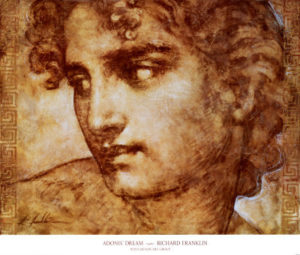
As soon as she glimpsed the child's beauty, Persephone, the dark goddess, fell in love with him, and she, too, wanted him for herself. The goddess-mothers fought over the beautiful infant and turned to Zeus (as in the Judgment of Solomon), the father of the gods. Unlike Solomon, Zeus decided that the mothers must divide the beautiful child according to the seasons, until he grew up and could also receive a third of the seasons for himself alone. The charming boy, who became a beautiful lad, was nurtured by Aphrodite, the goddess of beauty of love, who made him her consort and lover. The lover-lad gave up his own season, the third that was meant for him, when he grew up. He was led to belong entirely to his mother, the sensuous goddess Aphrodite. However, jealousy arose in the heart of Persephone, the queen of the underworld, and she insisted that the boy also belonged to the kingdom of death.
She aroused the envy of Ares, the god of war, Aphrodite's consort, and he, in his anger, sent a wild boar, which killed the youthful Adonis. Anemones grew from Adonis' blood. Although Adonis descended to the underworld, according to Aphrodite's wish, he returns every half year, with the arrival of spring, and helps the flowers to bloom, and then he goes back to the underworld for the winter. Adonis became the god of women, the god whose rites scattered the fragrance of the myrrh tree, which symbolizes his mother.
In the worship of Adonis, women would sacrifice their hair, and when they came to the temples, they would bring small gardens, symbolizing their femininity, as a gift.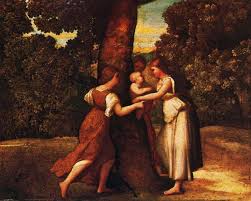
Adonis is also born in the shadow of his mother's tragedy, a tragedy connected with Eros and incestuous family relations; it is a tale in which beauty, love, and Eros become problematic in the woman's life.
Family relations transform into erotic relations, terminating in torment, expulsion, and severance. In this myth, as well, all the women in the story– Myrrha, Aphrodite, Persephone, and the myrrh tree– may be interpreted as aspects of the mother.
In her perversion Myrra, as her father's daughter, wanders about in the world lacking both love and the will to live, but her child is born from the tree, and thus saved. Although in its incipient stages, the mother-child connection contains a feeling of excitement, in this case the mother (Aphrodite) remains a divine representative for her son, charged with erotic super powers, infused by desire. For her child is the god Eros himself, who will imbue her with vital power, saving her from her death wishes; for the miserable mother,
the beautiful baby arouses the instinct for love, and the renews the desire for life. Through the power of his beauty, his vitality, and the hope within him, the baby arouses the desire for love and Eros in his mother, along with maternal feelings; the mother is in love with her baby.
Powerful emotions and urges are aroused by the beautiful child, unveiling the hidden seductive face of the mother; eroticization serves as the central compensation in her life. On the face of things, the image of the seductive mother, needing erotic satisfaction from her child, appears deviant, but if we expand the concept of Eros to signify the general drive to live, this face of the mother will amplify its meaning.
The image of the baby bringing life, giving love, and opening up the mother's heart is self-evident. But if the mother's need for love is unbearably great, either because of past relationships or relations with her husband, then her new baby will have increased importance as fulfillment or compensation.
The baby or child who lives his life of love for the sake of his mother, like Adonis, relinquishes that life to his goddess mother; for her, he sacrifices himself, his Eros, and his vitality. Behind the concerned, enveloping and fostering mother, lies the seductive mother, with her great need for love. In this case maternity is partial and lacking, because it is largely dictated by the mother's erotic needs. In the hope of gaining true love, the boy forfeits himself even further.
In this article I will not expand upon the catastrophic results of this relationship. I will merely make a number of points. First, in a place where all the components of motherhood are necessary, it reveals a glorification and dangerous devotion to beauty–particularly to Eros. Second, the myth represents the split between Eros and Thanatos, both of which exist in this kind of motherhood. Seduction and exploitation of the child, of his beauty and his vital energy, engender a feeling of death; both the mother and her son, Adonis, wander between life and death.
The mother tries to correct her life, to overcome death, which is in her, through the son – or the daughter; unable to fulfill this wish, and as punishment for that inability, the son or daughter try to forfeit themselves. In the end the son or daughter are left with a great void, unable to live their lives. They lose ability to engage their Eros for themselves, and their own satisfaction. Even if they manage to create a relationship, it will be based on the other, whom they serve in a quest for the lacking parental love.
The third myth deals with the narcissistic aspect of motherhood, a veiled aspect that has always existed in relations between mother and child.
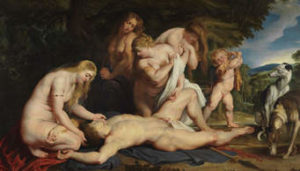
Liriope (of the Lily Face), the Mother of Narcissus (17)
A Mother who Uses her Children as a Reflection of her Image and Self-Esteem
Liriope was a beautiful nymph, desired by everyone, and the river god Cephissus raped her cruelly while she was bathing in his water. From this cruel rape, the violent encounter between the masculine and the feminine, was born the infant Narcissus (Anaesthetization or frozen in senses), whom all the river nymphs loved, and for his mother he was a marvelous compensation for the injury she had undergone. He grew up among the nymphs and was a source of pride to his mother and of envy for the others.
It is told that Liriope, the mother, was very fearful for her special son's fate, and she went to get advice from a soothsayer to obtain better control over his fate. The prophet Tiresias predicted the boy's future, saying that Narcissus would live as long as he did not know himself, and that the moment he knew himself, he would die. Narcissus' mother did not understand the meaning of the prophecy and she continued raising him with great pride. During his development, Narcissus parted from his mother, kept his distance, and became a cold and alienated boy.
When both girls and boys wanted to approach him, he declared loudly that he would rather die than allow anyone to rule over him or his feelings, and therefore he would never fall in love with anyone. Out of all his lovers, only the nymph Echo fell desperately in love with him and refused to give up his love. Echo, whose punishment was that she was able only to repeat the words of other people, was the one who reverberated for him as an extension of his mother. Narcissus did not reply to Echo. He caused her great distress, and in her frustration and weeping, she became a pillar of salt, and only her voice is heard in nature.
Boys also fell in love with Narcissus, and it is told that one disappointed and angry boy cursed him so that he would feel the pain of impossible love. Nemesis, the goddess of revenge, responded to the boy's curse and made Narcissus suffer that way. Once when Narcissus was alone near a pool of clear and virgin water in a clearing in the forest, he saw his own reflection and, not knowing that it was himself, he fell in love with it.
Narcissus, in love with the boy reflected from the water, gradually realized that the handsome lad was himself. This knowledge of disappointed love shattered his soul. He became obsessive about his reflection and fatally addicted to self-regard. His soul was tormented. He stopped attending to his bodily needs until he died. In the pool that had served him as a mirror a narcissus flower grew, symbolizing his soul.
In his prose poem, “The Disciple,” Oscar Wilde wrote:
When Narcissus died the pool of his pleasure changed from a cup of sweet waters into a cup of salt tears, and the "Oreaads"(nymph of the woods) came weeping through the woodland that they might sing to the pool and give it comfort.
And when they saw that the pool had changed from a cup of sweet waters into a cup of salt tears, they loosened the green tresses of their hair and cried to the pool and said, 'we do not wonder that you should mourn in this manner for Narcissus, so beautiful was he.'
'But was Narcissus beautiful?' said the pool.
'Who should know that better than you?' answered the Oreaads. 'Us did he ever pass by, but you he sought for, and would lie on your banks and look down at you, and in the mirror of your waters he would mirror his own beauty.'
And the pool answered, 'But I loved Narcissus because, as he lay on my banks and looked down at me, in the mirror of his eyes I saw ever my own beauty mirrored.'18
Oscar Wilde well understood the ambiguity of the pool as symbolizing the mother whose children reflect her back to herself. She does not even see their beauty, therefore her grief is not for the loss of her son but for the lost possibility of seeing her own beauty. This mother is dependent on her children to feel her own value and importance. The narcissistic mother is so wounded that the world around her must nurture her value, glorify her beauty, maintain her youth, and provide her with the feeling of success.
Liriope, the mother of Narcissus and the woman with the lily face, cruelly injured by the river god, fears the fate of her son because she dreads the loss of the object that proves her worth. The beautiful baby bestows upon his mother the possibility of mending her injured life, and healing her wound. Her use of her child as an object to reflect herself, and her fear of losing him, cause him to flee her; he shuts himself up within himself, and blunts his emotions, so as not to sense the absence of his selfhood. But secluding himself does not solve his problem, because, as Kohut states, Narcissus continues to seek his mother's observing eyes,and their reflecting mirror.
The women in Narcissus' life, including the mother figure, the nymph Echo, and the pool which reflects his image, are all bodiless mothers, who desire him, but do not supply his needs. Behind their appearance there is no enclosing, no nurturing, no true maternal presence. His mother, though beautiful, is essentially the lovely mask of a wounded and narcissistic woman; Echo, reverberating emptily, without feelings, can never be a true counterpart.
According to Schwartz-Salant, Echo's voice is unembodied, containing no meaning, like that of an alienated mother(20) The pool is a mirror leaving him completely alone with himself;
These three hidden faces of the other, leave the child hungry for love. Because the child who tries to satisfy the mother through narcissism becomes himself a tool for her needs, his tragedy—and that of every child like him– is a dual tragedy. Emotionally secluded like her, he cannot show her true warmth and love, or reveal his true self.
Ultimately the frustration is mutual. The son realizes that the mother is using him for her needs, and the mother, unable to feel him or receive his love, obsessively and unconsciously repeats the earlier, past injury.
The dark narcissism emanating from the mother’s strong sense of deprivation, may cause her to develop intensely vengeful and hostile feelings. She perceives such situations as acts of betrayal; her responding narcissistic anger against the child can be enormous, and cruel in murderous ways. She is liable to boycott and abandon the child in the most destructive manner; the moment the child separates from her, the moment he is no longer hers, all his good qualities become hateful. Because of the separation and her lack of satisfaction, she envies her child; in extreme situations she will even try to damage those qualities she exalted in the past. Like an abandoning husband, the child who is separated becomes the enemy.
The wound which characterizes the dark, narcissistic side of motherhood is difficult to heal. A narcissistic mother, because of her vulnerability, cannot bear any criticism of her motherhood, and will continue to be injured by her children, and to injure them.
* * *
I would like to expand on the subject of motherhood and its dark face, as it applies to all situations in which the image of the mother– and especially mother-child relations– are a leading motivation.
When the child, patient, or person being counseled needs to grow, to achieve independence, and follow a personal or professional path, the narcissistic, dark face present in all parent-like relationships can cause them to suffer from various narcissistic complexes. The therapist, counselor, teacher, or spiritual guide, strives to bring the “child” to a new place of development, but within this relationship, as well, the hidden elements we have been discussing may easily be aroused. These authority figures, with whom a deep and powerful connection is made, may be preoccupied by themselves and also use the other to reflect their value.
Everyone in treatment who accords importance to therapist-patient relations is influenced, to one degree or another, by the motif of the Great Mother; the three dark faces discussed in this article may be significant for them.
The malign face of Cybele, the mother figure with the axe, symbolizes the power and aggressiveness which are hidden behind maternal giving. Gugenbuhl Craig(21) shows that power is one of the darkest sides of psychotherapy and the helping professions. He claims that we need to be aware that great giving may sometimes conceal a vast, exaggerated need for power and control. Just like mothers, whose essence and potency are limited to the home, therapists may lack a sense of empowerment outside of the therapy room.
The therapist can fall into the same trap as does the mother whose sole arena is motherhood and her relations with her children, of exerting power– even excessive power– in relations with patients or people being counseled. Like the mother, who is convinced she is doing everything for her children's sake, the therapist can also find himself controlling his or patients without inhibitions. And like Attis, who castrates himself for the sake of the Great Mother, the patient, person being counseled, or student, may also conceal their will and power, sacrificing them out of fear or love of the therapist. This surrender may originate in fear of the loss of love, or the terror that sometimes takes place in therapy, or even a combination of the two.
Drawing life and Eros from children, as in the stories of Myrrha and Adonis, can also be a lurking shadow, hidden from the eyes of the therapist and the patient. The young, beautiful woman patient, the creative and talented therapist, or the energetic student, overflowing with life, who bring life to the dyadic relationship, can fall into the same trap as the mother who, through the act of giving, in fact takes what she lacks for herself.
Love and Eros may be positive for the bond, if it leads to creativity, curiosity, and enrichment, but concealed from sight, may instead lead to exploitation, misuse, and immobilization.
The unconscious erotic energy obscured behind the curtains, can lead to sexual relations within the therapeutic situation; the damage is similar to that of sexual relations between parents and their children. The mother who was herself the victim of incest, like Myrrha, the mother of Adonis, can transfer her distress to her son. She can also refrain from physical contact with the child and from open demonstrations of love, thus reenacting the sexual abuse she suffered from her own parents.
A male therapist who experiences the close, intimate intensity which arouses powerful Eros, can unconsciously convince himself that sexual behavior can benefit the female patient with whom he is so closely connected.
The dark face of motherhood can be aroused in all situations involving such intense, intimate closeness, or– as Jung put it–mystical participation.(22)
To the degree that the boundaries become fragile, and the separation blurred, the dark (perilous?) side of motherhood can easily enter. She is in danger in cases where the sterilization of the mother lies in the shadow,( 23) along with the misery of her life, and the overwhelming yearning for a lover. This is especially true when her relations with her husband and her surroundings in general are not satisfying. She will then seek vitality through the connection with her children.
In all the myths presented here, the mother's life was unhappy, in all of them she had an anguished connection with the father, and in all of them the absence of a mother-figure was conspicuous.
One may penetrate to the hidden motivations presented in this article by entering one’s own individual personal shadow. Both myths and life experience illustrate that these elements receive enhanced power when the husband, the children's 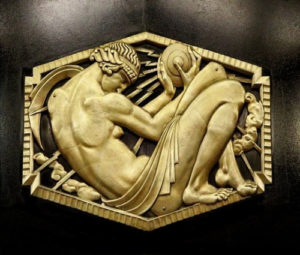 father, does not exist, is not significant, or still dependent himself upon his own mother figure.
father, does not exist, is not significant, or still dependent himself upon his own mother figure.
Bibliography
Bachofen J.J.:1948 Das Mutterecht (Gesamelte Werke,vol 1,3) Basel pub.
Kerenyi C. 1979 The Gods of the Greeks library of congress catalog "The Story of Attis" ch.4 pp88 , " The Story of Adonis
pp.75
Graves R. 1955 The Greek Myths vol1 Narcissus pp- 85 Penguin books Harmon worth, Middleesex,England Humbert E 1984:C.G.Jung . The fundamentals of theory and Practice Chiron Publication
Jecoby M. ,1990 Individuation &Narcissism' The psychology of Self in Jung – Kout Routledge , myth of Narcissus pp-18-29
Kohut H. 1971 , The Analysis of The Self 'NewYork 'Int.Univ.Press
Kohut H. 1977, The Restoration of the Self Int. Univ.Press N.Y.1977
Miller E.1992 הדרמה של הילד המחונן הוצאת דביר 1992 תל-אביב
Neumann E.: 1954, The Origin and History of Conciousness Routledge Kegan Paul PP-88-100
Neumann E.1963, The Great mother Bullingen Faundation inc.N/Y.1963
Gugenbuhl-Craig,A:1978 Power in the Helping Proffessions,Zurich:Spring Publications Schwartz-Slant N 1982. Nacissism and Chracter Transfomation' Inner City Winnicot D.W 1992. :Primary Meternal Preoccupation in Through Pediatrics to Psycho-Analysis, Karnac Books pp,300-305
